| Green heron Temporal range: Pleistocene–present PreꞒ Ꞓ O S D C P T J K Pg N ↓ | |
|---|---|

| |
| Green heron have iridescent green feathers on their wings | |
| Call | |
| Conservation status | |
 Least Concern (IUCN 3.1) | |
| Scientific classification | |
| Domain: | Eukaryota |
| Kingdom: | Animalia |
| Phylum: | Chordata |
| Class: | Aves |
| Order: | Pelecaniformes |
| Family: | Ardeidae |
| Genus: | Butorides |
| Species: | B. virescens |
| Binomial name | |
| Butorides virescens (Linnaeus, 1758) | |

| |
| Range of B. virescens Breeding range Year-round range Wintering range | |
| Synonyms | |
|
Ardea virescens Linnaeus, 1758 | |
The green heron (Butorides virescens) is a small heron of North and Central America. Butorides is from Middle English butor "bittern" and Ancient Greek -oides, "resembling", and virescens is Latin for "greenish".
It was long considered conspecific with its sister species the striated heron (Butorides striata), and together they were called "green-backed heron". Birds of the nominate subspecies (no matter which taxonomic arrangement is preferred) are extremely rare vagrants to western Europe—for example, a sighting in Pembrokeshire in 2018 was only the second recorded sighting in Wales; individuals from the Pacific coast of North America may similarly stray as far as Hawaii.
Description
The green heron is relatively small; adult body length is about 44 cm (17 in). The neck is often pulled in tight against the body. Adults have a glossy, greenish-black cap, a greenish back and wings that are grey-black grading into green or blue, a chestnut neck with a white line down the front, grey underparts and short yellow legs. The bill is dark with a long, sharp point. Female adults tend to be smaller than males, and have duller and lighter plumage, particularly in the breeding season. Juveniles are duller, with the head sides, neck and underparts streaked brown and white, tan-splotched back and wing coverts, and greenish-yellow legs and bill. Hatchlings are covered in down feathers, light grey above, and white on the belly.
The green heron's call is a loud and sudden kyow; it also makes a series of more subdued kuk calls. During courtship, the male gives a raah-rahh call with wide-open bill, makes noisy wingbeats and whoom-whoom-whoom calls in flight, and sometimes calls roo-roo to the female before landing again. While sitting, an aaroo-aaroo courtship call is also given.
Measurements:
- Length: 16.1–18.1 in (41–46 cm)
- Weight: 8.5 oz (240 g)
- Wingspan: 25.2–26.8 in (64–68 cm)
Taxonomy
As noted above, this species was formerly included in B. striata, which at that time was erroneously known as B. striatus. The Early Pleistocene B. validipes, whose fossil remains were discovered in Florida, might have been the ancestor of the green heron as the living species seems to replace the extinct relative in the fossil record.
Subspecies distinction is uncertain at best. The color variation between populations is less pronounced than between birds of the same population. Migratory populations are longer-winged than those resident year-round, but this cannot be used to delimit subspecies as it is quite obviously a consequence of differing habits and can be expected to undergo convergent evolution in unrelated populations of this species that just share the same habits. Thus, thorough molecular phylogenetic studies would be required to resolve the question of subspecies delimitation.
The following subspecies are commonly listed, though the validity of most of them is seriously disputed:
- Butorides virescens anthonyi (Mearns, 1895)
- Breeds in the United States west of the Rocky Mountains, south to northern Baja California Peninsula, Mexico. Some resident, most migrate to western Mexico in winter.
- Butorides virescens bahamensis (Brewster, 1888)
- Bahamas. Resident.
- Butorides virescens frazari (Brewster, 1888)
- Southern Baja California Peninsula, Mexico. Resident.
- Butorides virescens maculata (Boddaert, 1783) – formerly maculatus
- Southernmost US through Central America to central Panama, Caribbean. Resident.
- Breeds from southeastern Canada to central and southern US east of the Rocky Mountains. Winters from southernmost US to northern South America.
Much of the dispute hinges upon the distinctness of the Caribbean and Central American populations, the second taxon in this species to be described. To describe the two most extreme views, some authors assemble the bulk of the mainland population in the nominate subspecies but treat the parapatric populations as distinct subspecies, while others place all resident populations in maculata and all migratory ones in virescens.
Ecology

The habitat and foraging area of the green heron includes riparian zones, wetlands, ponds, and lakes, as well as human-made canals and ditches. Green herons do not exhibit a particular preference for diurnal or nocturnal foraging, often engaging in both. Shore-living individuals adapt to the rhythm of the tides. They mainly eat small fish, frogs and aquatic arthropods, but may take any invertebrate or vertebrate prey they can catch, including such animals like leeches, earthworms, dragonflies, damselflies, waterbugs, grasshoppers, spiders, crayfish, prawns, mice, other rodents, lizards, tadpoles and snakes. Some of the many fish eaten are: minnows, sunfish, catfish, perch, eels and, in urban areas, goldfish. Green herons are intolerant of other birds – including conspecifics – when feeding and are not seen to forage in groups. They typically stand still on shore or in shallow water or perch upon branches and await prey. They are able to hover briefly to catch prey. Green herons have been observed using captured prey (e.g. mayflies) or other objects (bread, feathers) to "bait-fish" – using a lure on the water's surface to attract fish. This bait-fishing behavior is common among herons.
The northern population moves to its breeding ranges during March and April; near the northernmost limit of the green heron's range, breeding is well underway by the end of May. The migration to the winter quarters starts in September; by late October, the birds are absent from regions where they do not stay all year. At least the northward migration does not seem to be affected by global warming; birds appear in their breeding ranges at the same time they did 100 years ago.
Individuals of non-migratory populations abandon their territories after breeding season to roam about the region. They may or may not return to the previous year's breeding location, depending on whether they found better habitat during these wanderings. In these populations, the breeding season is determined by rainfall and consequent prey availability.
Green herons are seasonally monogamous. The pairs form in the breeding range, after an intense courtship display by the males, who select the nesting sites and fly in front of the female noisily and with puffed-up head and neck plumage. They nest in forest and swamp patches, over water or in plants near water. Nests are a platform of sticks, often in shrubs or trees, sometimes on the ground. Locations in trees are preferred, with some nests built up to 20 m (66 ft) off the ground although heights of several meters are more common. Rarely, large numbers of these birds congregate in heronries for nesting.
The clutch is usually 2–6 pale green eggs, which are laid in two-day intervals (though the second egg may be laid up to six days later than the first). After the last egg has been laid, both parents incubate for about 19–21 days until hatching, and feed the young birds. The frequency of feedings decreases as the offspring near fledging. The young sometimes start to leave the nest at 16 days of age, but are not fully fledged and able to fend for themselves until 30–35 days old. Sometimes – particularly in the tropical parts of its range – the green heron breeds twice a year.
Tool use
Green herons are one of the few species of bird known to use tools. In particular, they commonly use bread crusts, insects, or other items as bait. The bait is dropped onto the surface of a body of water to lure fish. When a fish takes the bait, the green heron then grabs and eats the fish.
Gallery
-
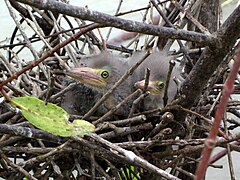 Nestlings
Nestlings
-
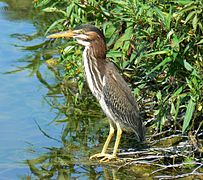 Subadult retaining some juvenile plumage
Subadult retaining some juvenile plumage
-
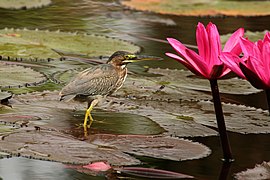 Young adult B. v. virescens
Young adult B. v. virescens
-
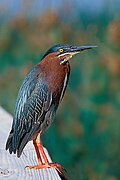 Breeding plumage, with neck retracted
Breeding plumage, with neck retracted
-
 Adult
Adult
-
 Adult
Adult
-
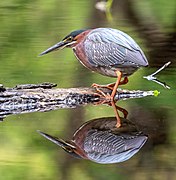 Hunting in New York
Hunting in New York
-
 in Guatemala
in Guatemala
-
 Subspecies B. v. maculata with neck extended
Subspecies B. v. maculata with neck extended
-
 Juvenile, Glastonbury, CT USA
Juvenile, Glastonbury, CT USA
References
- BirdLife International (2022). "Butorides striata". IUCN Red List of Threatened Species. 2022: e.T22728182A163804848. doi:10.2305/IUCN.UK.2022-2.RLTS.T22728182A163804848.en.
- Jobling, James A (2010). The Helm Dictionary of Scientific Bird Names. London: Christopher Helm. pp. 81, 402. ISBN 978-1-4081-2501-4.
- "Rare green heron spotted in Llanmill, Pembrokeshire". BBC News. 30 April 2018. Retrieved 30 April 2018.
- ^ Jutglar, Francesc (1992): 33. Green-backed Heron. In: del Hoyo, Josep; Elliott, Andrew & Sargatal, Jordi (eds.): Handbook of Birds of the World (Volume 1: Ostrich to Ducks): 417, plate 28. Lynx Edicions, Barcelona. ISBN 84-87334-10-5
- ^ Cornell Lab of Ornithology. "Green Heron". Retrieved 2010-04-08.
- ^ Dewey, T. & Butzbaugh, J. (2001): Animal Diversity Web: Butorides virescens. Retrieved 2008-FEB-12.
- "Green Heron Identification, All About Birds, Cornell Lab of Ornithology". www.allaboutbirds.org. Retrieved 2020-09-26.
- "ITIS Report: Butorides virescens". Integrated Taxonomic Information System. Retrieved 28 August 2014.
- ^ Moore, Amanda A.; Green, M. Clay; Huffman, David G.; Simpson, Thomas R. (2016). "Green Herons (Butorides virescens) in an Urbanized Landscape: Does Recreational Disturbance Affect Foraging Behavior?". The American Midland Naturalist. 176 (2): 222–233. doi:10.1674/0003-0031-176.2.222. JSTOR 44840286.
- ^ "Butorides virescens (Green Heron)" (PDF). The Online Guide to the Animals of Trinidad and Tobago. University of the West Indies.
- ^ "Butorides virescens (Green heron)". Animal Diversity Web.
- ^ Davis Jr., William E.; Zickefoose, Julie (1998). "Bait-fishing by Birds: A Fascinating Example of Tool Use". Bird Observer. 26 (3): 139–143.
- Henninger, W.F. (1906). "A preliminary list of the birds of Seneca County, Ohio" (PDF). Wilson Bulletin. 18 (2): 47–60.
- Ohio Ornithological Society (2004): Annotated Ohio state checklist Archived 2004-07-18 at the Wayback Machine.
- Cornell Lab of Ornithology. "Green Heron". Retrieved 2011-05-11.
- Seattle Audubon Society. "Green Heron". Archived from the original on 2016-03-04. Retrieved 2010-04-08.
- "Green Heron Overview, All About Birds, Cornell Lab of Ornithology". www.allaboutbirds.org. Retrieved 2022-05-22.
External links
- Butorides virescens – Green heron at Animal Diversity Web
- Green heron – Butorides virescens – USGS Patuxent Bird Identification InfoCenter
- Green heron at eNature.com
- Field Guide on Flickr
- "Butorides virescens". Integrated Taxonomic Information System. Retrieved 9 February 2006.
- YouTube video of a green heron fishing
- YouTube Video of a Green Heron drowning a frog before eating it!
- Bermuda Dept. of Environment and Natural Resources green heron page
- "Green-backed heron media". Internet Bird Collection.
- Green heron photo gallery at VIREO (Drexel University)
- Green heron species account at Neotropical Birds (Cornell Lab of Ornithology)